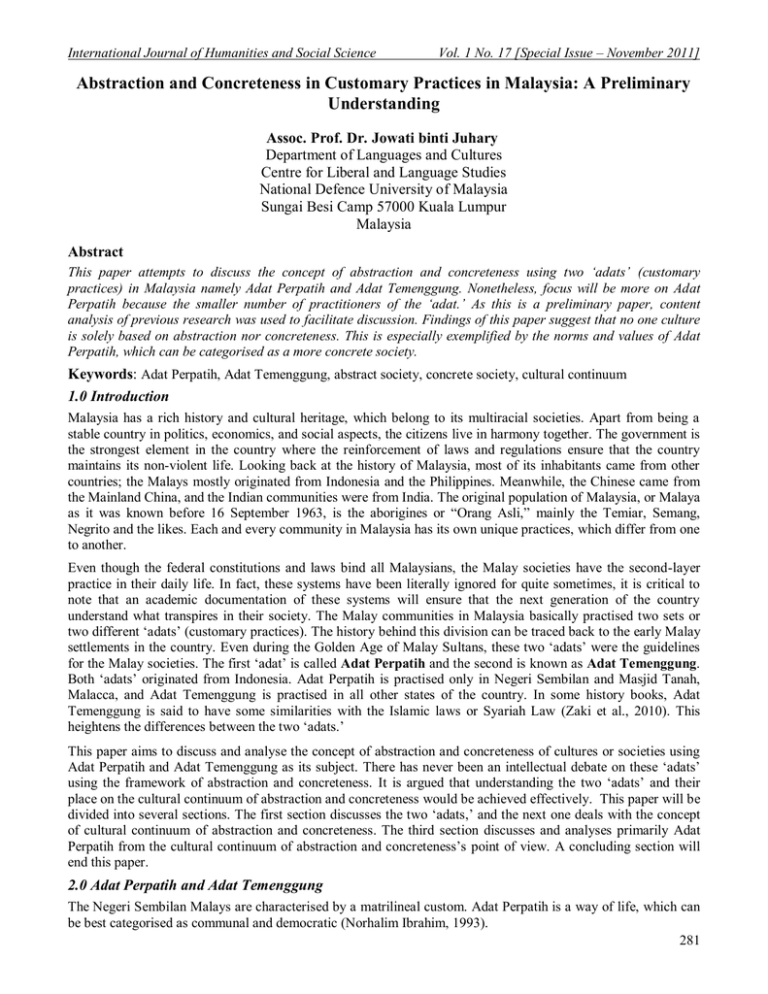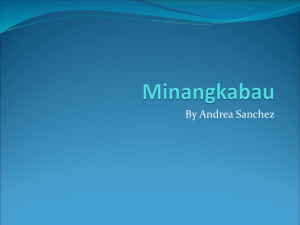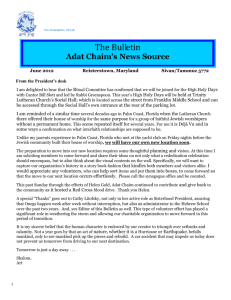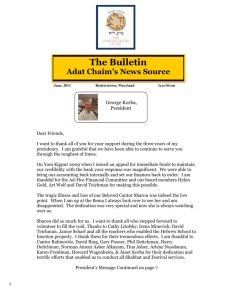Document 10466943
advertisement

International Journal of Humanities and Social Science Vol. 1 No. 17 [Special Issue – November 2011] Abstraction and Concreteness in Customary Practices in Malaysia: A Preliminary Understanding Assoc. Prof. Dr. Jowati binti Juhary Department of Languages and Cultures Centre for Liberal and Language Studies National Defence University of Malaysia Sungai Besi Camp 57000 Kuala Lumpur Malaysia Abstract This paper attempts to discuss the concept of abstraction and concreteness using two ‘adats’ (customary practices) in Malaysia namely Adat Perpatih and Adat Temenggung. Nonetheless, focus will be more on Adat Perpatih because the smaller number of practitioners of the ‘adat.’ As this is a preliminary paper, content analysis of previous research was used to facilitate discussion. Findings of this paper suggest that no one culture is solely based on abstraction nor concreteness. This is especially exemplified by the norms and values of Adat Perpatih, which can be categorised as a more concrete society. Keywords: Adat Perpatih, Adat Temenggung, abstract society, concrete society, cultural continuum 1.0 Introduction Malaysia has a rich history and cultural heritage, which belong to its multiracial societies. Apart from being a stable country in politics, economics, and social aspects, the citizens live in harmony together. The government is the strongest element in the country where the reinforcement of laws and regulations ensure that the country maintains its non-violent life. Looking back at the history of Malaysia, most of its inhabitants came from other countries; the Malays mostly originated from Indonesia and the Philippines. Meanwhile, the Chinese came from the Mainland China, and the Indian communities were from India. The original population of Malaysia, or Malaya as it was known before 16 September 1963, is the aborigines or “Orang Asli,” mainly the Temiar, Semang, Negrito and the likes. Each and every community in Malaysia has its own unique practices, which differ from one to another. Even though the federal constitutions and laws bind all Malaysians, the Malay societies have the second-layer practice in their daily life. In fact, these systems have been literally ignored for quite sometimes, it is critical to note that an academic documentation of these systems will ensure that the next generation of the country understand what transpires in their society. The Malay communities in Malaysia basically practised two sets or two different „adats‟ (customary practices). The history behind this division can be traced back to the early Malay settlements in the country. Even during the Golden Age of Malay Sultans, these two „adats‟ were the guidelines for the Malay societies. The first „adat‟ is called Adat Perpatih and the second is known as Adat Temenggung. Both „adats‟ originated from Indonesia. Adat Perpatih is practised only in Negeri Sembilan and Masjid Tanah, Malacca, and Adat Temenggung is practised in all other states of the country. In some history books, Adat Temenggung is said to have some similarities with the Islamic laws or Syariah Law (Zaki et al., 2010). This heightens the differences between the two „adats.‟ This paper aims to discuss and analyse the concept of abstraction and concreteness of cultures or societies using Adat Perpatih and Adat Temenggung as its subject. There has never been an intellectual debate on these „adats‟ using the framework of abstraction and concreteness. It is argued that understanding the two „adats‟ and their place on the cultural continuum of abstraction and concreteness would be achieved effectively. This paper will be divided into several sections. The first section discusses the two „adats,‟ and the next one deals with the concept of cultural continuum of abstraction and concreteness. The third section discusses and analyses primarily Adat Perpatih from the cultural continuum of abstraction and concreteness‟s point of view. A concluding section will end this paper. 2.0 Adat Perpatih and Adat Temenggung The Negeri Sembilan Malays are characterised by a matrilineal custom. Adat Perpatih is a way of life, which can be best categorised as communal and democratic (Norhalim Ibrahim, 1993). 281 The Special Issue on Humanities and Behavioral Science © Centre for Promoting Ideas, USA As a conceptual system, Adat Perpatih includes both specific rules that replicate and generate the behaviour of its society. The name of this „adat‟ is believed to be taken from the name of the inventor, Datuk Perpatih Nan Sebatang, one of the village rulers in West Sumetara and later in Negeri Sembilan. The system of life in Adat Perpatih differs from Adat Temenggung in several aspects. For example, they differ in the set-up of marriage, practice of social and economic activities, and work etiquette (Nordin Selat, 1982). Adat Perpatih, as mentioned above, is a matrilineal system. Thus, the women of Negeri Sembilan as a rule get the property for their position is an immensely strong one. To understand why this is the case, it is pertinent to look at how the community in Adat Perpatih is formed. As acutely summarised by Nellie Tan and Patel (1992), clan descent does through women – “a man is a member of his mother‟s clan until by marriage he is received into his wife‟s. Women may not travel; the husband settles in his wife‟s village – not the wife in the husband‟s.” However, this does not mean that the male population is being „slaved‟ by the female or has a lower position in the community. The male still becomes the leader of the community and the women still have to respect and follow their leads. Nellie Tan and Patel further argue that the premier merits of Adat Perpatih are its humanity and its tremendous simplicity that brought “its provisions within the knowledge of everyone.” Though after sometimes, the Islamic laws influence Adat Perpatih, most of its customs remain especially the importance of women in property acquisition. That is why some scholars imply that Adat Perpatih is against the Islamic teaching for it gives mor e priority to women rather than the men (Zaki et al., 2010). However, as a saying goes “Biar mati anak, Jangan mati adat” [Let the child die, do not let the customs be vanquished], most practitioners of Adat Perpatih maintain their customary practice and at the same time try to assimilate Islamic practice as well. The Adat Perpatih has been described as primitive but democratic; on the other hand, Adat Temenggung has been described as cruel and autocratic (Nellie Tan & Patel, 1992). Adat Temenggung basically has the opposite qualities and characteristics of Adat Perpatih. Most of its rules and regulations have been modified and it takes many Islamic practices due to the similarities of both principles in Islamic Laws and Adat Temenggung. Adat Temenggung gives more attention to male population because they are the leaders and have a lot of responsibilities in protecting their belonging including the women and children. In this „adat,‟ the men do not have to „move-in‟ to the women‟s clan/house; the vice-versa is the norm. As this paper aims to place the classification of both „adats‟ into their proper position on the cultural continuum, it is best now to have some insights into the abstraction and concreteness of cultural continuum. 3.0 Cultural Continuum of Abstraction and Concreteness Cultures, on the whole, are the embodiment of human thoughts, activities, behaviour, life styles and communication. In this globalised era and with the rapid change in society, it is very vital for individuals to know their very own culture. There are many cultures and sub-cultures, and thus the need to communicate and understand others is essential. Before this paper discusses the framework in this section, culture should be defined appropriately. Culture is, …a system of competence shared in its broad design and deeper principles, and varying between individuals in its specificities, is then not all of what an individual knows and thinks and feels about his [or her world]. It is his [or her] theory of what his [or her] fellows know, believe, and mean, his [or her] theory of code being followed, the game being played.…….(Keesing 1974 quoted in Gudykunst, Ting-Toomey & Nishida, 1996: 5) Culture offers guidelines for suitable behaviours and sets of codes adopted by members of society. Failure to follow the guidelines in certain cultures may cause a member to be labelled as an „outsider.‟ There are also individual differences within cultures. That is, in both collectivist and individualist cultures, one can find individuals who are allocentric (pay primary attention to the needs of a group) or idiocentric (pay more attention to their own needs than to the needs of others). Allocentric people want to help serve the needs of their group because it gives them personal satisfaction. Idiocentric people are more interested in serving their own needs and its members of a collectivist culture, they give attention to the needs of others out of a sense of obligation (Triandis, Brislin & Hui, 1988). As a framework is vital to be the basis of discussion, this paper is now going into details of the working parameters of the framework. The framework is actually a systematic division of cultures in this world into two major categories, and thus it is not a simple dichotomy of cultures. 282 International Journal of Humanities and Social Science Vol. 1 No. 17 [Special Issue – November 2011] This will be explored in greater detail below. The idea of the framework derived from Buber (1949), Coyle (1988) and D‟Cruz and Steele (2000). Buber deals with the ideas of two types of human relations in his book I and Thou where he claims that human relations are divided into two kinds; I-It and I-Thou. He suggests that in the I-It relations, people are more interested in a relationship that is detached emotionally between the participants. The relations exist in a medium of time and space – meaning, every relation will be dependent upon these two aspects. Meanwhile, the I-Thou relationships are more concerned with „real‟ relationship where people depend upon each other, and are interested in a lasting relation. There is no medium for the relationship to exist. It can be anywhere and everywhere as long as people in the community want it (Buber, 1949: 100). Coyle (1988) elaborates on the notions first introduced by Buber. She adds that characteristics of the two types of „relations‟ are different, and thus explain why people from the respective cultures (that is why the needs to alter the „relations‟ into cultures, societies or groups are vital because the relations exist in the context of society, cultures or groups themselves) differ. Coyle‟s research would have one to conclude that the people from the I-It relations/cultures are more distant, lack closeness and warmth and operate in an atmosphere of individuality (individualist cultures/societies). On the other hand, she argues that people in the I-Thou relations/cultures have a special bond that binds them together, thus making them aware of the need to be depended upon one another and to operate independently in and within the community (collectivist cultures/societies) (Coyle, 1988: 2). In addition, she concludes that the work of Buber has relevance to the social and psychological renewal because I-It and I-Thou can be integrated systematically. D‟Cruz and Steele (2000) have placed cultures on a continuum with the more abstract culture at one end and the more concrete culture at the other. This placement on the continuum informs scholars and readers alike that the two types of cultures actually have relations, and the relations are manifested along the continuum. Another characteristic of this continuum is that every point on the continuum possesses both elements of the two ends. This suggests that if point B is situated nearer to the abstract end, it will have more of the abstract characteristics and less concrete characteristics. Further, no one culture (marked by the points on a continuum) is a purely concrete or purely abstract culture. Each culture possesses elements of both the concrete and the abstract. The relevance here is marked by the word more to denote the orientation of a culture. For instance, this paper would refer to a particular culture as a more abstract or concrete culture, thus denying the claim that the culture is a solely and purely concrete or abstract culture. Due to changes that occur in a culture, it may move towards the opposite side. Such movement explains why some cultures show evidence of having confirmation of different values: some older and some new. These characteristics of culture become significant in the discussion of cultures and societies because they are able to explain some transformation in the community. D‟Cruz and Steele (2000) add further characteristics to both abstract and concrete cultures. Basically, they opine that the more abstract culture is more egalitarian in nature. This suggests that members in the community have equal access to almost everything. Attention should be paid so as not to violate the privacy of others since everybody is equal, and has his/her own individual rights. People in this community thus value individuality and prefer to exercise their independence. Furthermore, they also value autonomy and encourage that everyone works on their self-initiative power. The opposite is true for the more concrete culture. They operate within the hierarchical manner. It means they will have to respect and value the authority of the superior. Such relations are in the cases of mother-daughter relationships, ruler-follower relations and the likes. The most striking characteristic is that members in this culture have a stronger sense of belonging and group identity. This is because they operate within the parameter of group work/orientation. People in this more concrete cultures will value the rights of the groups more than the right of individuals. 4.0 Discussion From the above explanation on the two customary practices and the framework of abstraction and concreteness, it is rather obvious that the concreteness is more evident in Adat Perpatih and the abstraction is more in Adat Temenggung. This is, nonetheless, the general assumption. To justify this claim, this section is going to highlight and match evidences taken from sources of previous research. Notwithstanding this, discussion will only revolve around Adat Perpatih according to several aspects of life. It must be emphasised that the arguments in this paper are not to label Adat Perpatih as the better system than Adat Temenggung; rather since the existing system in Malaysia is similar to Adat Temenggung, this paper would like to highlight the characteristics of Adat Perpatih and its concrete values. 283 The Special Issue on Humanities and Behavioral Science © Centre for Promoting Ideas, USA 4.1 Working concepts of the ‘adat’ There are four categories of „adat‟ in Adat Perpatih; (a) Adat nan Sebenar Adat [the real Adat], (b) Adat yang Teradat [becomes „adat‟ due to conscious decision or decree on the part of ancestral culture, heroes or traditional leaders], (c) Adat yang diadatkan [made „adat‟ in the specific past], and (d) Adat Istiadat [tradition or habitual customs] (Norhalim Ibrahim, 1993). The practice of Adat, regardless of whether it was social, economical or political was based on two basic and fundamental codes of ethics. They are the concepts of Muafakat (consensual agreement) which was very democratic in nature, and the concept of Menyerapa, Bekerjasama and Gotong Royong (reciprocal aids, co-operative and group effort respectively). The concept of Muafakat requires that any matters had to be taken during a Kerapatan (gathering of all those involved). During this process, members would discuss the problems and means or ways to solve the problems, and other related matters. This act of problem solving during the „Kerapatan‟ is termed as Muafakat (agreement, a convention or compromise to end any dispute). The other concept of „Bekerjasama‟ and „Gotong Royong‟ ensure that all members of society do their shares. The „adat‟ as a dynamic and functioning system, specifies different types of jobs to society members depending on their abilities, physical and mental conditions. As such, the achievement and gain of society are not stressed as individual achievement. It is rather categorised and claimed as an achievement and gain of a group (Norhalim Ibrahim, 1993; 3). Thus this is very much the more concrete culture where the interest of the group comes first. The Adat Perpatih stresses strongly on material gaining as a symbol of status. However, the group material aging is what the members are searching for. The more concrete culture, according to the framework, works within the boundary of teamwork and team spirit. Clearly, in this aspect, Adat Perpatih is a more concrete „adat‟ or equivalent to culture and custom. Every member is useful, irrespective of status and position. They must cooperate with one another so that socially, they become prosperous and progress with time. To achieve this, the 'adat‟ reminds its members that they must act according to their positions in society and be seen as a responsible person. 4.2 Marriage rituals of the ‘adat’ Marriage according to the „adat‟ of Negeri Sembilan is an institution in which rules and rituals not only brought together a man and woman into a lawful union, but also establish and maintain links between lineal groups. These affinal ties are essential in binding the suku organisation into cohesive whole. Again, in this aspect of Malays Negeri Sembilan, all group members will be helping with the complicated rituals of marriage. The rituals are complicated because of the hierarchy relations in this more concrete society – stages and steps must be fulfilled as a show of respect to the elderly and rituals themselves. Decisions are not made individually since the elderly will act as the advisors (based on the hierarchy). Although in Adat Perpatih, the women are more dominant, when it comes to marriage life, the men must still provide for the family. The husbands must arrange for the new family to live in their own household and the house will then belong to the wife, and the daughters. 4.3 The concept of ‘Malu’ (Ashamed) in the ‘adat’ All members in society must contribute to the wealth and stability of the group. This is because the wealth belongs to the whole members of society; the concept of individual wealth is non-existent in Adat Perpatih. During labour, everybody regardless of status and position will help. One important feature in Adat Perpatih is the concept of „malu‟ (ashamed) if one family fails to make use of the land properly. This creates difficulties and embarrassment not only to the individual family but also to the rumpun, ruang, perut and suku (divisions of groups in Adat Perpatih according to the number of members and importance) as expressed by the maxim, Malu tak dapat diagih Shame that cannot be divided Suku tak dapat dianjak Suku that cannot be changed The more concrete society is well-known for the concept of „malu‟ because the close-knitted relations between group members. It is argued that the more abstract society treats „malu‟ as guilty. Due to the nature of individualism in the more abstract society, „malu‟ is thus treated as an individual trait; it is not shared by all group members. 284 International Journal of Humanities and Social Science Vol. 1 No. 17 [Special Issue – November 2011] 5.0 Conclusion From the brief discussion above, it can be concluded that Adat Perpatih is of a more concrete culture. Today only minimal aspects of the „adat‟ is followed, and changes in how society perceives and embraces life has further lessened the impact and importance of Adat Perpatih. However, much is yet to be done in order to have a fulllength study on this matter. As stated earlier, culture may change and so does the position on the continuum. This can be illustrated by one saying in the „adat,‟ Yang buruk dibarui the old, to be renewed Yang usang diganti the withered to be replaced This saying indicates that if the „adat‟ is out-dated, it has to change to suit the current time, space and environment. However, change, if there is, must go through the Muafakat procedure – Ibu Adat Muafakat (the mother of Adat is consensus agreement). Thus, Adat Perpatih is not a static system. It can, it has and it will change to suit the contemporaries values of its society without deviating from its norms and values. References Buber, M. (1949). I and Thou. New York: Scribner. Coyle, C. (1988). Faith Community and Education. Unpublished Master‟s Thesis. La Trobe University Australia. D‟Cruz, J.V. & William Steele. (2000). Australia’s Ambivalence Towards Asia: Politics, Neo/Post-colonialism, and Fact/Fiction. Monash: Monash Asia Institute, Monash University Press. Gudykunst, W.B., Ting-Toomey, S. & Nishida, T. (eds.). Communication in Personal Relationships Across Cultures. Thousand Oaks, CA: Sage. Nellie Tan & Patel, V. (1992). Adat Perpatih: The Matrilineal System in Negeri Sembilan, Malaysia and other Matrilineal Kinships Systems Throughout the World. Kuala Lumpur: Wintrac Sdn. Bhd. Nordin Selat. (1982). Sistem Sosial Adat Perpatih. Kuala Lumpur: Utusan Malaysia Publications. Norhalim Ibrahim. (1993). Adat Perpatih: Perbezaan dan Persamaanya dengan Adat Temenggung. Kuala Lumpur: Fajar Bakti. Triandis, H., Brislin, H. & Hui, C. (1988). Cross-cultural training across the individualism-collectivism divide. International Journal of Intercultural Relations, 12, 269-289. Zaki, P.H., Mohd Zaki Hamzah, Mohd Hasmadi Ismail, Khairil Wahidin Awang & Hazandy Abdul Hamid. (2010). Malay Customary Tenure and Conflict on Implementation of Colonial Land Law in Peninsular Malaysia. Journal of Law and Conflict Resolution, 2(2), 33-45. 285






